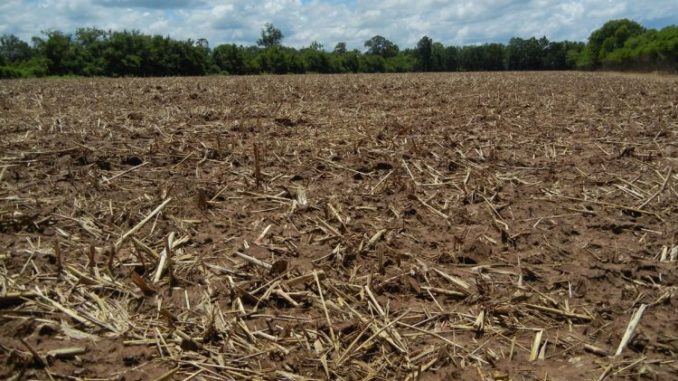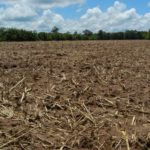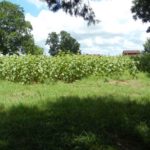
Tips to avoid being ticketed for hunting over a baited field
I hugged the ground a little tighter and turned my head to the side as shotgun pellets ripped through the trees overhead. Leaves cut from the branches sifted down around me while I listened to the shouts and laughter emanating from the source of the gunfire.
Cautiously raising my head, I looked at a fellow wildlife agent lying flat on the ground beside me. He grinned and shrugged while the unspoken “how do we get in these situations?” question simultaneously went through our minds once again.
We were not in a gunfight, and the shooting was not directed at us. In fact the shooters were unaware of our presence.
They were far more interested in shooting at the mourning doves pouring into the field just beyond our hiding place on this September afternoon, which marked opening day of dove season.
A week or so earlier, an anonymous caller reported that the field might be illegally baited. We secretly visited the field and confirmed those suspicions.
So here we were, working the illegal hunt.
As the afternoon continued, I focused on the number of people on the field, making mental notes on their location, physical description, clothing and the number of birds each one shot.
I tried not to think about the number and location of chiggers and ticks happily climbing onboard as I lay in the woods.
As the afternoon waned, the shooting slowed and the hunters began showing signs of leaving. My partner and I radioed the two agents watching the area where the hunters had parked their vehicles.
We then moved out into the field, identified ourselves and gathered the hunters. The other agents arrived and we began the standard separate interviews with each hunter, while checking licenses, guns and numbers of doves each possessed.
We informed the hunters the field was illegally baited, asking them if they were aware of it, if it had been discussed and whether they made any individual effort to determine whether the field was legal.
The field was small — three of four acres at most. The remains of a spring garden occupied the central area, and someone had mowed around the perimeter.
Liberal (and I mean very liberal) amounts of wheat and sunflower seed had been poured out in strips the length of the field. It was obvious the seed had come from sacks that had been opened and carried through the field allowing the seed to flow from the open sacks as they were carried along.
We were fairly certain of that, since some of the seed sacks were still laying along the edge of the field where the wind had blown them against brush.
In spite of the obvious and overwhelming evidence, the hunters denied any knowledge of illegal baiting. The self-appointed spokesperson for the group went so far as to claim he called the local LDWF office and talked to one of the “game wardens” and received assurance it was OK to “fix the field like this.”
When asked for the name of the person with whom he had the discussion, he dropped his head, stared at the ground and said he did not have the person’s name. We pressed a little harder asking for the date he made the call and the number he called from so we could confirm it through the phone records.
At that point he didn’t want to talk about it anymore.
This field was typical of bait illegally placed for doves and obvious to anyone, including every member of the small family group involved. They eventually entered guilty pleas and took their medicine.
But not all cases are so obvious, and it is possible for an unsuspecting hunter to be caught up in a baited-field situation without ever having any intention to break the law.
Let’s take a look at what is legal and what isn’t, how to tell the difference and what to do in situations where we are not sure.
I don’t know if it is done anymore, but a few years ago LDWF, the LSU Agriculture Center’s Cooperative Extension Service and the US Fish and Wildlife Service hosted a number of dove field seminars for hunters and landowners.
Discussions included rules and regulations, and attendees were taken on a tour of small fields prepared by Extension Service professionals.
The fields were enhanced for doves through legal agricultural and wildlife management practices. We can take a brief look at the legal fields presented at those seminars, since they remain the best examples of good and acceptable places to hunt doves.
The first example is the plain, simple open pasture, hayfield or timber cutover. These clearings frequently have native grasses or other plants that bear seed in late summer when dove seasons open.
These openings may be mowed or cut for hay, and the resulting scattered seeds are often attractive to doves.
Sometimes mowing is not even necessary, as is the case with timber cutovers. Our hunting lease is timber company land, and some portion of it is always newly cutover with goat weed and other native plants present. A few of the members get together every year on opening day and manage to find doves somewhere in the cutovers.
We don’t exactly melt the gun barrels, but some of the better shots manage to get a limit from time to time.
Harvested crop fields are often great dove attracters. Corn, rice and milo harvest begins in August. Waste grain in the harvested fields will attract good numbers of birds, especially when the field is near a water source or is surrounded by trees or power lines.
Harvested crop fields also provide great shooting during subsequent segments of the season later in the fall.
A lot of people seem surprised to learn that planting and mowing or manipulating crops grown on a field for dove hunting is legal. Sunflowers and the various varieties of millet may be planted in early or mid-summer, and then mowed and hunted over for dove. Commercial dove-hunting operations frequently use the practice, and small landowners can often have good shooting on four or five acres by planting for doves.
But remember that, while growing and mowing or manipulating a crop for doves is legal, such crops may not be mowed or manipulated for waterfowl.
Remember also that bringing in and scattering additional seed in the field is illegal.
Our final dove field example is fall planting for cool-season forage or a winter wheat crop. Of all situations and practices this seems to be the one most often used as a guise for the illegal placement of bait.
Fall plantings — whether for wildlife food plots, livestock grazing or crop harvest — must follow official recommendations consistent for the area in order to be legally hunted.
Those recommendations include planting dates, soil preparations, planting methods and amount of seed per acre.
There is no problem with hunting on areas prepared in accordance with official recommendations. But steer clear of areas where the planting conflicts with recommended dates, soil tilling is lacking or inconsistent and seed seems to be in excessive amounts, unevenly distributed or scattered around in piles.
The case described at the beginning of this column is a classic example of such a situation.
Hunters can avoid problems by taking a few simple precautions.
If invited to hunt a field, the first thing to do is find the owner or person in charge and ask how the field was prepared and if it is baited.
Then, before even attempting to shoot any birds, take a look around for bait. If the soil has been tilled or harrowed, kick some over and make sure nothing questionable such as an abundant blend of seed or feed has been covered.
If anything seems suspicious do not hunt.
Finally, don’t bother contacting your local wildlife agent and asking him to come out to inspect and approve a field for hunting. He won’t.
The reason he won’t is that, although the field might be just fine when he visits, he has no idea what will take place after he leaves.
Keep it legal, keep it safe and have fun.




